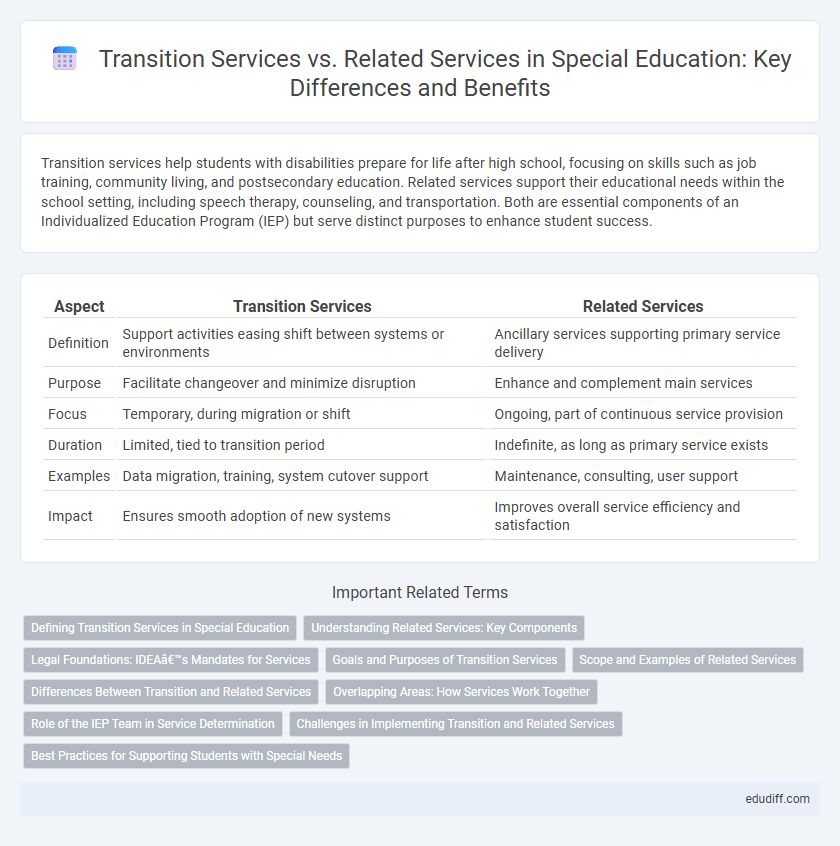Transition services help students with disabilities prepare for life after high school, focusing on skills such as job training, community living, and postsecondary education. Related services support their educational needs within the school setting, including speech therapy, counseling, and transportation. Both are essential components of an Individualized Education Program (IEP) but serve distinct purposes to enhance student success.
Table of Comparison
| Aspect | Transition Services | Related Services |
|---|---|---|
| Definition | Support activities easing shift between systems or environments | Ancillary services supporting primary service delivery |
| Purpose | Facilitate changeover and minimize disruption | Enhance and complement main services |
| Focus | Temporary, during migration or shift | Ongoing, part of continuous service provision |
| Duration | Limited, tied to transition period | Indefinite, as long as primary service exists |
| Examples | Data migration, training, system cutover support | Maintenance, consulting, user support |
| Impact | Ensures smooth adoption of new systems | Improves overall service efficiency and satisfaction |
Defining Transition Services in Special Education
Transition services in special education are designed to facilitate the shift from school to post-school activities, including postsecondary education, vocational training, employment, and independent living. These services are tailored to the individual needs of students with disabilities and are outlined in the Individualized Education Program (IEP) starting by age 16, encompassing instruction, community experiences, and career counseling. Unlike related services, which primarily support educational access, transition services emphasize long-term goals and skill development for adult life success.
Understanding Related Services: Key Components
Related Services encompass essential support activities that enable students with disabilities to benefit from special education, including transportation, speech-language pathology, counseling, and occupational therapy. These services are tailored to individual needs as outlined in an Individualized Education Program (IEP) to enhance access and participation in educational settings. Understanding the scope and implementation of Related Services ensures effective delivery and compliance with regulatory requirements under IDEA.
Legal Foundations: IDEA’s Mandates for Services
IDEA mandates that Transition Services are designed to achieve post-school goals for students with disabilities, specifically focusing on employment, education, and independent living skills. Related Services under IDEA include supportive services such as transportation, counseling, and speech therapy necessary for a child to benefit from special education but are not primarily aimed at transition outcomes. The legal foundation differentiates Transition Services as results-oriented, while Related Services provide essential supports enabling access to educational programs.
Goals and Purposes of Transition Services
Transition Services aim to prepare students with disabilities for post-school life by focusing on goals such as employment, independent living, and further education through targeted instruction, community experiences, and related services. These services are designed to be goal-oriented, individualized, and outcome-focused to ensure successful movement from school to adult life. Related Services support Transition Services by providing essential assistance like speech therapy, counseling, or transportation to help students achieve their transition goals effectively.
Scope and Examples of Related Services
Transition services encompass a broad range of tailored activities designed to prepare students with disabilities for post-secondary life, including education, employment, and independent living. Related services specifically refer to supportive services such as speech therapy, occupational therapy, counseling, and transportation that directly assist students in benefiting from their special education programs. The scope of related services is focused on facilitating access to core educational goals, while transition services target long-term objectives that extend beyond the school environment.
Differences Between Transition and Related Services
Transition services in special education are specifically designed to support students moving from school to post-school activities, including post-secondary education, vocational training, employment, and independent living. Related services, by contrast, encompass a broad range of supportive measures such as speech therapy, occupational therapy, and counseling that enable students to benefit from their special education. The primary difference lies in the purpose and timing: transition services target future readiness and independence beyond school, while related services focus on enabling current educational access and progress.
Overlapping Areas: How Services Work Together
Transition services and related services overlap significantly in supporting students with disabilities during school-to-adulthood shifts, ensuring continuity in education and life skills development. Transition services emphasize career exploration, vocational training, and post-secondary planning, while related services provide essential therapies such as speech, occupational, and counseling that facilitate access to these goals. When integrated, these services create a holistic support system that addresses both academic and functional needs, optimizing student outcomes in independence and community involvement.
Role of the IEP Team in Service Determination
The IEP team plays a crucial role in distinguishing between Transition Services and Related Services by assessing the student's individualized needs and post-secondary goals to develop a tailored education plan. Transition Services focus primarily on preparing students for life after high school, including vocational training, post-secondary education, and independent living skills, while Related Services provide the necessary support, such as speech therapy or counseling, to help the student benefit from their IEP. The team's collaborative decision-making ensures that service determinations align with legal requirements and effectively support the student's academic and functional achievement.
Challenges in Implementing Transition and Related Services
Implementing transition services and related services in special education faces challenges such as coordinating multidisciplinary teams, adhering to individualized education plans (IEPs), and securing adequate funding. Schools often struggle with aligning resources to meet diverse student needs during the transition from school to post-school activities. Ensuring compliance with federal mandates like IDEA while managing limited staff expertise further complicates service delivery.
Best Practices for Supporting Students with Special Needs
Transition services focus on preparing students with special needs for post-secondary goals, including education, employment, and independent living, by providing tailored instruction, counseling, and workplace experiences. Related services support the student's access to the educational environment through therapies such as speech, occupational, and physical therapy, ensuring effective learning participation. Best practices emphasize coordinated planning, individualized goal setting, and collaboration among educators, families, and community resources to optimize student outcomes.
Transition Services vs Related Services Infographic

 edudiff.com
edudiff.com